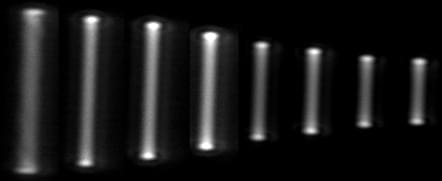A nanoresonator trapped in ultrahigh vacuum features an exceptionally high quality factor, showing promise for applications in force sensors and macroscopic tests of quantum mechanics.
Nanomechanical oscillators could be used to build ultrasensitive sensors and to test macroscopic quantum phenomena. Key to these applications is a high quality factor (Q), a measure of how many oscillation cycles can be completed before the oscillator energy is dissipated. So far, clamped-membrane nanoresonators achieved a Q of about 1010, which was limited by interactions with the environment. Now a team led by Tracy Northup at the University of Innsbruck, Austria, reports a levitated oscillator—a floating particle oscillating in a trap—competitive with the best clamped ones [1]. The scheme offers potential for order-of-magnitude improvements, the researchers say.
Theorists have long predicted that levitated oscillators, by eliminating clamping-related losses, could reach a Q as large as 1012. Until now, however, the best levitated schemes, based on optically trapped nanoparticles, achieved a Q of only 108. To further boost Q, the Innsbruck researchers devised a scheme that mitigated two important dissipation mechanisms. First, they replaced the optical trap with a Paul trap, one that confines a charged particle using time-varying electric fields instead of lasers. This approach eliminates the dissipation associated with light scattering from the trapped particle. Second, they trapped the particle in ultrahigh vacuum, where the nanoparticle collides with only about one gas molecule in each oscillation cycle.









Comments are closed.